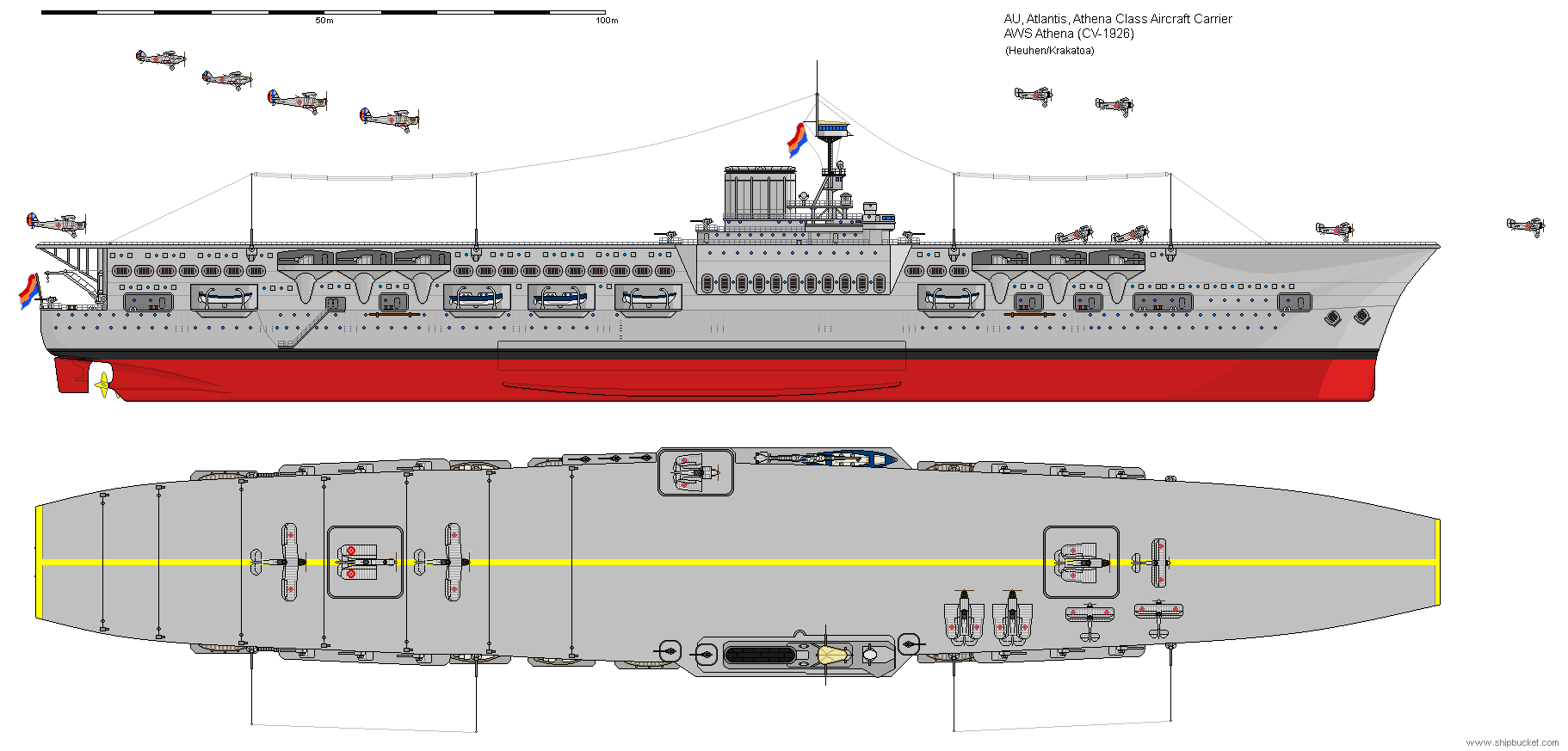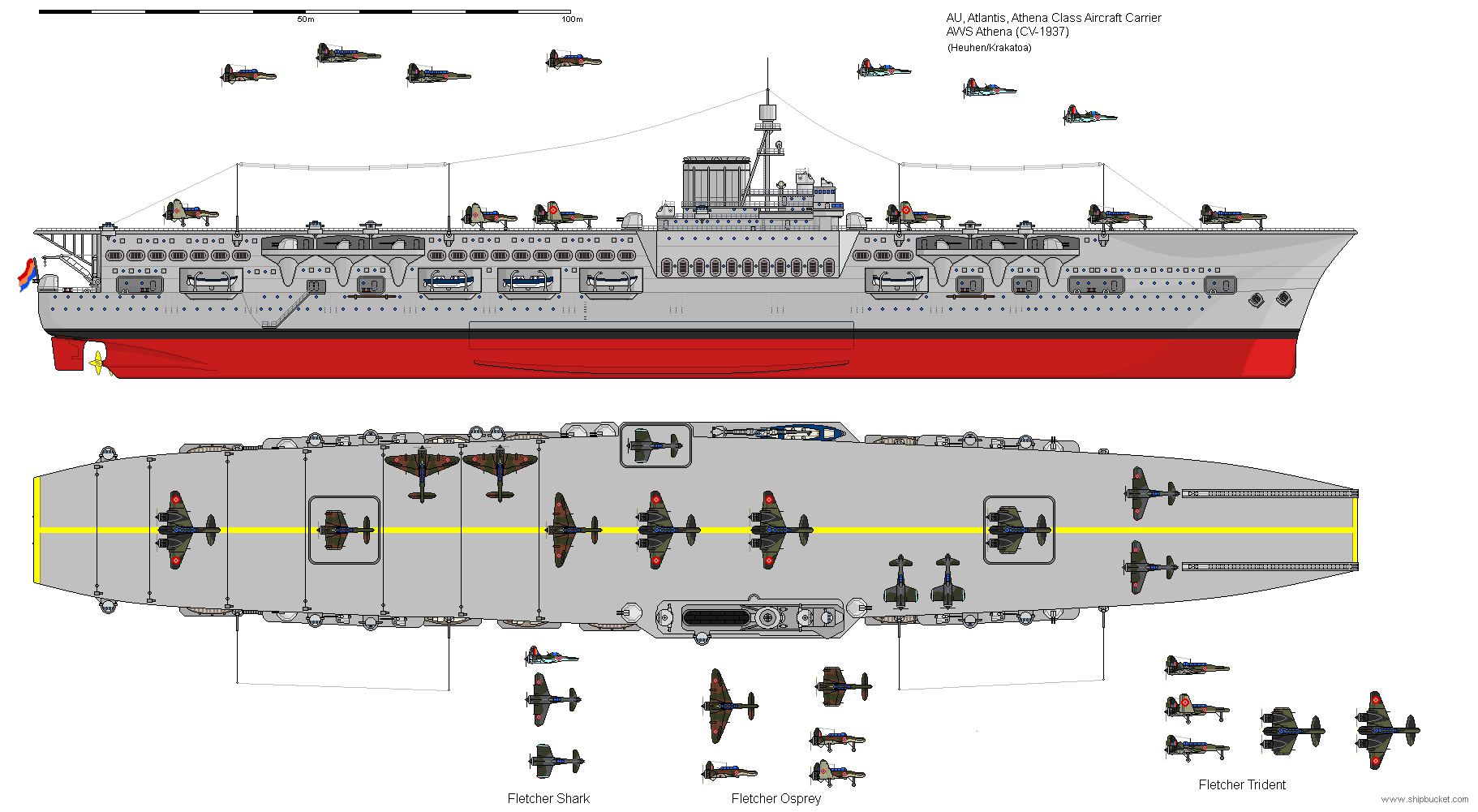
The three early Atlantean aircraft carriers (Chronos, Athena, Aphrodite) proved the concept for the Admiralty. With the Athena's being completed in 1926, it would be another 6 years before the next classes plans would be completed and the ships laid down for completion in 1936. The Athena's spent the ten years between completion and their upgrades trialing all sorts of equipment that would be fitted to the new carriers. Aircraft would change a lot during this period and the 1939 aircraft complement would reflect this.
As upgraded through to 1938:
Displacement: 47,000 tons standard, 55,500 tons full load.
Dimensions: 816 x 110 (hull) x 33 feet
Machinery: 4 shaft, steam turbines, 160,000shp,
Speed: 30 knots
Endurance: 9,000 miles @ 15 knots.
Armour: 5" side, 4.5" deck, 1.5" Flight deck,
Armament:
16 x 4" (8x2)
40 x 40mm (10x4)
Aircraft: 80
Crew: 1,920 - 2,100 wartime

During the inter-war period, Atlantis spent a lot of time and money trialing all sorts of aircraft, engines, armaments and layouts. The one layout which proved a winner for the Navy was the Canard configuration. Three types were eventually produced, a fighter, a bomber, and a divebomber. By 1939 the forward firing armament had settled on a variant of the 1" (25.4mm) auto-cannon. The fighter had four in the nose, while the bombers had two, one in each wing. If an enemy aircraft flew in front of an Atlantean aircraft, the Admiralty wanted all its aircraft to have a chance of shooting it down. (Some time in the future I will try FD scale for these, SB scale for now.)
Athena's war:
The Athena started the war doing patrols to intercept German warships and blockade runners. The Athenas group intercepted 4 blockade runners, but missed the Scharnhorst and Gneisenau when they transitted the area. The Athena and its escorts were sent to strengthen the Mediterranean fleet operating out of Alexandria. Various actions with the fleet were undertaken through to November 1940 when Athena and Illustrious launched their aircraft off and into history that would be known as the Taranto Battle. 1941 and after receiving damage the Athena was transferred to Trincomalee for repair. There the ship joined the Zeus, Hades and other escorts. The fleet trained together during October and November when orders were received to proceed to Singapore, there to join Admiral Philips and Force Z. December 9, and Force Z were proceeding up the Malaysian coast to intercept the Japanese invasion force. The Japanese knew of Force Z and had one of its main bases at Camranh Bay overflowing with strike aircraft ready to pounce once the sighting had been made. The Athena and Indefatigable were trailing the main battlefleet by 40 miles, when the call for air support was received. The amount of enemy aircraft (300+) meant that the CAP of six aircraft were sent to their deaths as a gesture. A decent force of 36 fighters were launched and these were dispatched in time to save the Zeus but had to watch the final moments of the other three Capital ships. Another 24 fighters were flown off and were to escort Zeus back toward the carriers. Both carriers reversed course and got the hell out of Dodge. The Japanese knew they had missed the carriers and another force were sent to find them. The carriers were ready for them and were met by a force of 50 fighters and 36 Dive bombers cleaned up to attack the bombers. The Japanese failed to damage the carriers, one of the escorting cruisers received a torpedo hit but made it to Singapore. The problem the Force Z carriers had was that each Japanese attack was reducing the effective Fighter force. No replacement aircraft for either carrier were at hand. Nearest were two dozen CKD aircraft aboard a freighter at Singapore. Only half of those were fighters and they were British fighters. Athena made it to Singapore and was ordered to Sydney straight away through the Sunda Strait, making it through before the Japanese closed the Strait catching Perth and Chicago. It would be another month before replacement aircraft were received and integrated into the ships squadrons. The Atlanteans had sent two ships full of CKD crated aircraft, enough to replace the ships whole aircraft complement. These ships moved to Brisbane where they awaited further instructions. Athena with its two AA cruisers and five destroyers were ordered north to join Admiral Fletcher and interdict the Japanese force moving toward Port Moresby. Athena's force was still to the south of Papua-New Guinea when the sighting reports were relayed from Admiral Fletchers force. The Athena raced north till it was in range of the Japanese force, then launched a full strike force. The air strike hit the Japanese about 25 minutes after Admiral Fletchers aircraft had attacked. The Japanese aircraft carriers were the main target with the transports as secondary targets. The strike force hit the Japanese force hard sinking the light carrier Ryuho and two of the transports. The air battle had been fierce with fighters from both sides shooting each other down. It was now that the extra forward firing armament was proved, with the bombers being able to cover each other and shoot at the fighters as they overshot from their attack runs. With the Japanese fleeing north the Athena joined the damaged Yorktown (the Lexington having been sunk) and escorted it to Pearl Harbour where the miracle repair occurred to get the Yorktown ready for the coming Battle of Midway. The Athena joined the American Task Force under Admiral Spruance and took part in the main battle, its aircraft helping to sink the three carriers in the first wave. The Hiryu's return strike missed the three US carriers but found the Athena, hit by two torpedoes and four large bombs, the Athena slowed drastically and started heeling to port. The damage parties were unable to stop the flooding and when a main frame collapsed the end was in sight and all non-essential crew and then the remaining crew were taken off by the Athena's escorts. Twenty minutes later the Athena fell onto its port side, boiler explosions blew out the side and down Athena went.
Aphrodite's war:
Paired with the Ares class battleships in September 1939, and went on interception patrols between Atlantis and the Pillars of Hercules. Joined Force H for the answer to the French Fleet question in July 1940. Operated with Force H for next 18 months as companion craft to the Ark Royal with one of the new Hercules class battleships pairing with the Renown. May 1941, and the Aphrodite and Ark Royal are ordered north to try to intercept the Bismarck, the remaining German ship from the Denmark Strait battle. The Bismarck is sighted and kept under observation while the Ark Royal and Aphrodite launch an air strike force to attack, they would have one chance before night fell. The number of aircraft (70+) overwhelm the Bismarck's air defenses and hit it with three torpedoes and five bomb hits. The one torpedo hit that sealed the Bismarck's fate hit the screws and rudder, jamming the rudder over so that Bismarck was steaming in circles. The combined force of battleships find Bismarck next morning and sink it. Aphrodite remained with Force H till early 1942 when it returned to Atlantis for refit and repair. Rejoining Force H in August, the Aphrodite loaded fifty Spitfires on its after deck to be flown off to Malta as part of the reinforcements carried by the Pedestal Convoy. Once the Aphrodite had flown off the Spitfires, the ship was then able to go back to flying off and on its own aircraft. For this convoy the Aphrodite was full of fighters to be used to attack and break up the Italian and German bomber attacks. With the other members of the covering force the Athena waited for the damaged ships from the night action and escorted them back to Gibraltar. Pedestal was deemed a success and allowed Malta to continue to be used to intercept Axis forces being sent to North Africa. Aphrodite remained with Force H during the invasions of Sicily and the Italian mainland culminating in the Italians surrender. 1944 found the Aphrodite operating with the Home Fleet out of Scapa Flow. Aphrodite during this time made attacks with other carriers on the Tirpitz and other German ships holed up in the Norwegian fjords. It also acted as distant cover with the Hercules on several convoys to and from Russia. Early in 1945 Aphrodite returned to Atlantis and was laid up in reserve. The Aphrodite had been worked hard and as one sailor put it "the poor old girl was just clapped out". The Aphrodite was sold for scrap in 1946.
That is just one version of Aphrodite's Wars. Being with Force H for its war service, it can also take part in the resolution of the Axis fleet post Denmark Strait (Scandinavia) where it plays a major part in breaking the hold of the FW-190A fielded by the Axis carriers with its own Fletcher Shark fighters which were almost as good as the FW-190A's. The Aphrodite's 35 Shark fighters are able to help fight a path through to the Axis carriers where the divebombers put the three Axis carriers out of action.